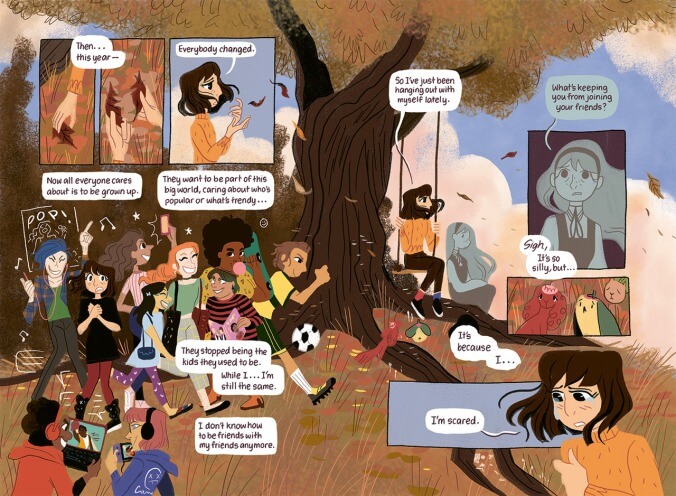Séance Tea Party teaches us the magic of growing up

In Malaysian graphic novelist Reimena Yee’s new book, Séance Tea Party, the fear of growing up is explored in heart-aching detail on the comic page. Lora Xi desperately doesn’t want to become a teenager, to the point that instead of spending time with her peers, her best friend is Alexa, a ghost perpetually stuck in her own pre-adolescence. Yee reminds the reader that growing up doesn’t have to entail abandoning childlike wonder; the story’s beautiful and moving execution demonstrates why it had to be a comic book. Without getting into spoiler territory, know that Séance Tea Party is a story in which Yee weaves together imagination, magic, and the very act of creativity.
Lora self-isolates from her peers because she assumes their passions—mainly different explorations and expressions of growing up—could never align with hers. Yee depicts Lora’s subsequent loneliness not as a void, but an area where her imagination flourishes (the opening pages literally depict her imagination). As anyone familiar with her Eisner-nominated masterpiece The Carpet Merchant of Konstantiniyya could guess, Yee once again strategically forgoes strict paneling for lavish, jaw-dropping backgrounds. In Séance Tea Party, the detailed and scenic spreads with which Yee often opens chapters linger in the reader’s mind. These details are reinforced in the pages with more traditional paneling (there are a few nine-panel grids here and there) as Yee puts pieces of them—leaves, fantastic creatures, animals, and the like—in the margins. It’s akin to the comics technique known as “crossing,” which Yee also uses in the book. She defined the term as when “an element crosses over from one panel to the next,” part of a useful Twitter thread about the language creators, critics, and fans can use to describe comics, instead of relying on traditional filmic language.
Yee’s interest in comics education seeps into Séance Tea Party. The backmatter of the book not only showcases Yee’s process, but gives the ambitious young reader a rundown of all the tools and techniques she used to create it. Other than the engaging beauty of the work itself, parents, guardians, and teachers interested in fostering the creative skills of children (or themselves) might appreciate this aspect of the book. Adults might also learn from the core message of Séance Tea Party: You don’t have to give up your childlike passion in growing up, even though no one can win a fight against time. Yet simultaneously, Yee acknowledges the beneficial nuance that change can bring; this is explored in heartrending manner through the character of Alexa lamenting her ghostly stasis.
Though there are many things for readers new to comics to appreciate in the book, Yee’s tendency towards pedagogy (she is the cofounder of UNNAMED, a Southeast Asian comics collective focused on visual literacy) means that Séance Tea Party appeals uniquely to visually literate comic readers. It is, after all, a story about the pitfalls of wanting to be trapped in a specific time. Comics are where the reader has ultimate control of time, allowing them to linger on a particularly beautiful page, comforting moment, or breathtakingly rendered panel. But we must turn the page—must go forward in time—to not only discover new wonders, but to appreciate the whole, just as in life.
